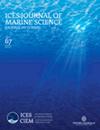鳞鱼(Cyclopterus lumpus)的跨大西洋基因组分化以及平行环境和等位基因变异
IF 3.4
2区 农林科学
Q1 FISHERIES
引用次数: 0
摘要
在种群数量大、扩散潜力高的海洋物种中,等位基因频率的大规模遗传差异和宗族趋势可以让人们深入了解形成多样性的进化过程。鳞鱼(Cyclopterus lumpus)分布于整个北大西洋,传统上被用来捕捞鱼子,最近被用作鲑鱼养殖中的清洁鱼。我们使用 70 K SNP 阵列来评估北大西洋的跨大西洋分化、遗传结构和宗族变异。东北大西洋和西北大西洋之间的海盆尺度结构差异显著,与发育/半知子体功能相关的基因座富集。我们在 2 号染色体上发现了一个假定的结构变异,这可能是造成东北大西洋和西北大西洋鳞鱼分化的原因,也与冰川期后跨大西洋的二次接触相一致。冗余分析确定了东北部(N = 1269 个位点)和西北部(N = 1637 个位点)的气候关联,它们之间有 103 个共享位点。在一些位点(西北部占 15%,东北部占 5%)中观察到了等位基因频率的宗族模式,其中 708 个位点与生长、发育过程和运动有关。跨大西洋分化、环境关联和宗族位点的综合证据表明,整个北大西洋存在着区域性和大规模的潜在适应性种群结构。本文章由计算机程序翻译,如有差异,请以英文原文为准。
Trans-Atlantic genomic differentiation and parallel environmental and allelic variation in Lumpfish (Cyclopterus lumpus )
In marine species with large populations and high dispersal potential, large-scale genetic differences and clinal trends in allele frequency can provide insight into the evolutionary processes that shape diversity. Lumpfish, Cyclopterus lumpus, is found throughout the North Atlantic and has traditionally been harvested for roe and more recently used as a cleaner fish in salmon aquaculture. We used a 70 K SNP array to evaluate trans-Atlantic differentiation, genetic structuring, and clinal variation across the North Atlantic. Basin-scale structuring between the Northeast and Northwest Atlantic was significant, with enrichment for loci associated with developmental/mitochondrial function. We identified a putative structural variant on chromosome 2, likely contributing to differentiation between Northeast and Northwest Atlantic Lumpfish, and consistent with post-glacial trans-Atlantic secondary contact. Redundancy analysis identified climate associations both in the Northeast (N = 1269 loci) and Northwest (N = 1637 loci), with 103 shared loci between them. Clinal patterns in allele frequencies were observed in some loci (15%—Northwest and 5%—Northeast) of which 708 loci were shared and involved with growth, developmental processes, and locomotion. The combined evidence of trans-Atlantic differentiation, environmental associations, and clinal loci, suggests that both regional and large-scale potentially-adaptive population structuring is present across the North Atlantic.
求助全文
通过发布文献求助,成功后即可免费获取论文全文。
去求助
来源期刊

ICES Journal of Marine Science
农林科学-海洋学
CiteScore
6.60
自引率
12.10%
发文量
207
审稿时长
6-16 weeks
期刊介绍:
The ICES Journal of Marine Science publishes original articles, opinion essays (“Food for Thought”), visions for the future (“Quo Vadimus”), and critical reviews that contribute to our scientific understanding of marine systems and the impact of human activities on them. The Journal also serves as a foundation for scientific advice across the broad spectrum of management and conservation issues related to the marine environment. Oceanography (e.g. productivity-determining processes), marine habitats, living resources, and related topics constitute the key elements of papers considered for publication. This includes economic, social, and public administration studies to the extent that they are directly related to management of the seas and are of general interest to marine scientists. Integrated studies that bridge gaps between traditional disciplines are particularly welcome.
 求助内容:
求助内容: 应助结果提醒方式:
应助结果提醒方式:


